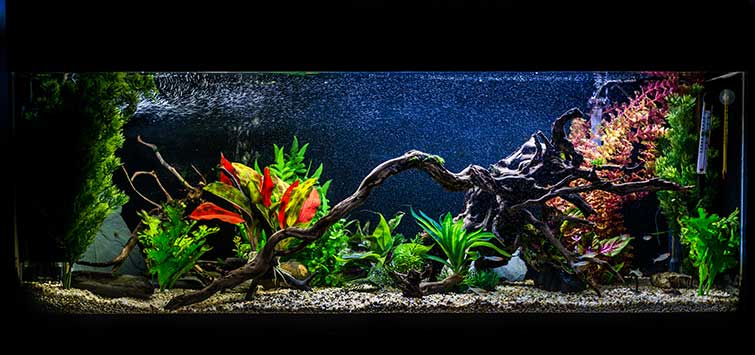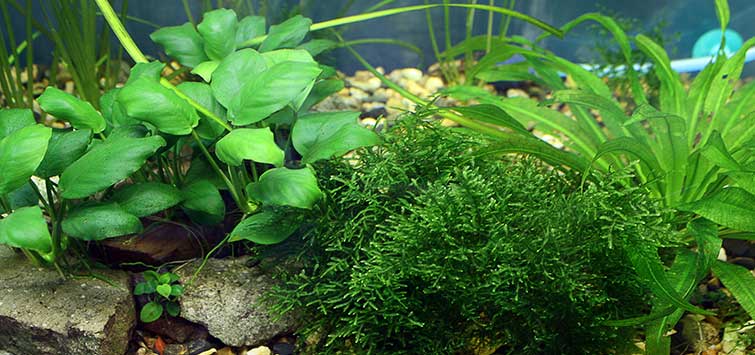Filtration in the Nature Aquarium
Author: Takashi Amano
The celebrated planted aquarium guru reviews some important filtration considerations for the Nature Aquarium, including filter volume, media, and water flow.
A filter is an indispensable piece of equipment for keeping fish in an aquarium. Although you can do without a filter for a short period of time, it is necessary to clean the water with some sort of filter if you would like to keep a fair number of fish healthy for a long time. And any emergence of algae is a big problem in an aquatic plant layout; this is also influenced greatly by the operation of a filter. Algae does not show up much if the filter has an adequate capacity and is populated with healthy filter bacteria. In this article, I am going to discuss how to select and maintain a filter in the Nature Aquarium.
The Advantage of External Filters
There are many types of filters, but an external filter is used most often in the Nature Aquarium. The advantage of an external filter is that it does not require equipment other than intake and outlet pipes in an aquarium, and therefore it does not put a limitation on the placement of aquatic plants, rocks, and driftwood. Unlike a top-mounted filter, it does not limit or block lighting.
Its filtering capacity is high because water passes through filter media efficiently, and it does not cause much CO2 loss since the filter is fully enclosed. CO2 is commonly added to an aquatic plant layout to facilitate the photosynthesis of aquatic plants, but while CO2 dissolves easily in water, it dissipates easily into the air as well. Although we cannot do anything about CO2 dissipating naturally from the water surface, we can minimize the loss of CO2 by keeping it from escaping from other areas.
Filter Volume and Water Flow
The important points to keep in mind when selecting an external filter are the volume of the canister and the flow rate of its pump. Since a larger canister holds more filter media, its filtering capacity will be higher as well. The flow rate of the pump determines how many times the water circulates through a filter in a unit of time. The more frequently the water circulates, the cleaner the water is going to be. However, you need to keep in mind that the flow is going to be stronger as well. Here is the guideline that I use for Nature Aquarium setups: 6 liters (1½ gallons) per minute flow for 60- to 180-liter (15- to 45-gallon) aquariums, 20 liters (5 gallons) per minute for 180- to 300-liter (45- to 75-gallon) aquariums, and 30 liters (8 gallons) per minute for 300- to 600-liter (75- to 150-gallon) aquariums [note: English equivalents approximated—Eds.].
If the flow is too strong, it causes aquatic plants to be uprooted or sway in the water and makes it difficult to create the layout you have in mind. On the other hand, adequate flow encourages aquatic plants to grow healthy. This is because the water current brings CO2 and nutrients around the leaves and enables aquatic plants to take them up efficiently. CO2 and nutrient molecules diffuse surprisingly slowly in the water. If there is no water flow, they tend to become limited locally around the leaves.
The current also washes off the organic matter collecting on the surface of leaves. The dirt that collects on the surface of leaves may induce algae to show up or trigger a disease. The dirt drifting in water is eventually sucked into an intake pipe and removed by the filter. A filter media removes such dirt from the water and decomposes it with the help of the filter bacteria.
Filter Media
A porous, rough-surfaced pumice stone media and activated carbon are the main filter media that I use in the Nature Aquarium. The dirt that is taken into the filter with water is trapped by the rough surface of the filter media and removed from the water. The dirt that is dissolved in water is adsorbed and removed by activated carbon. The trapped dirt feeds and encourages the microbes in the filter, such as bacteria and protozoans, to multiply and further break down the accumulated dirt.
However, if too much decomposed dirt, organic matter, and cellulose from decayed plant matter accumulate inside the filter, they reduce the flow and decrease the filtering capacity. This creates the condition commonly known as a clogged filter. When this happens, algae start to grow rapidly, and the clarity of the water decreases as well.
To remedy this, the filter media needs to be cleaned. To minimize damage to the filter bacteria, fill a bucket with water from the aquarium, and rinse the filter media in it to wash off the dirt. Activated carbon should be replaced at the same time. Although it depends on the condition of the aquarium, filter media maintenance should be performed once every three months to half a year as a general rule. If a lot of fish are kept and a lot of food is given, or if all the leaves of a Cryptocoryne melt suddenly in an aquarium, the filter media becomes dirty more quickly. The filter media in such an aquarium should be checked frequently.
Although the adsorption ability of activated carbon lasts only two weeks or so, you can keep using it well after that point, since filter bacteria inhabits its intricately porous surface from then on. However, if the filter media is washed, the filtering capacity decreases temporarily. Therefore we exchange activated carbon after the media cleaning to compensate for the loss.
Water Intake and Outlet
Lastly, the placement of the water intake and outlet pipes needs some consideration in an aquatic plant layout. If they are placed in highly visible places or without much care to the direction of water flow, they can spoil a precious layout. I use clear glass intake and outlet pipes for an external filter in the Nature Aquarium. They are inconspicuous in an aquatic plant layout, while providing adequate water current.
The outlet pipe should be place in the foreground area with low-growing plants so that the strong current from the outlet pipe can circulate easily throughout the entire aquarium. Then the water hits the glass surface on the opposite side and the weakened water current turns toward the background area, making it easy to grow tall aquatic plants back there. If the water flow is disrupted, dirt tends to collect, and since any areas where that happens tend to harbor pesky algae, you should try to visualize the water flow and carefully decide on the placement of the pipes to fit a layout so as not to disrupt the water flow.
DATA
Aquarium: Cube Garden Clear; W90 x D45 x H45 (cm)
Lighting: Solar (NAG-150W Green Lamp), turned on for 10 hours per day
Filter: Super Jet Filter ES-600 (Bio Cube, anthracite)
Substrate: Aqua Soil Amazonia, Bright Sand, Power Sand Special M, Bacter 100, Clear Super, Tourmaline BC, Penac W/for Aquarium, Penac P
CO2: Pollen Glass Large 30 mm, 3 bubbles per second via CO2 Beetle Counter (using Tower/20)
Aeration: 14 hours after the light is turned off using Lily Pipe P-4
Additives: Brighty K, Green Brighty STEP2
Water change: 1/3 once a week
Water quality: Temperature 25ºC, pH 6.8, TH 10 mg/l
Aquatic plants: Riccia fluitans, Glossostigma elatinoides, Echinodorus tenellus, Eleocharis acicularis, Eleocharis vivipara
Aquatic animals: Hyphessobrycon herbertaxelrodi, Otocinclus sp., Caridina japonica, Crossocheilus siamensis
DATA
Aquarium: Cube Garden 180-P; W180 x D60 x H60 (cm)
Lighting: Solar (NA lamp MH-150W Green) x 3 units, turned on for 10 hours per day
Filter: Super Jet Filter ES-2400 (Bio Rio, NA Carbon)
Substrate: Aqua Soil Amazonia, Power Sand Special L, Bacter 100, Clear Super, TourmalineBC, Penac W/for Aquarium, Penac P
CO2: Pollen Glass Beetle Series 50 mm, 6 bubbles per second via CO2 Glass Counter (using Tower/20)
Aeration: 14 hours after the light is turned off using Lily Pipe P-6
Additives: Brighty K, Green Brighty STEP2
Water change: 1/3 once a week
Water quality: Temperature 25ºC, pH 7.0, TH 20 mg/l
Aquatic plants: Hemianthus callitrichoides, Eleocharis acicularis
Aquatic animals: Hemigrammus bleheri, Otocinclus sp., Caridina japonica, Crossocheilus siamensis

.png?h=595&iar=0&w=2781&hash=5FD5E69473BCC22199FBFA2FB71B6033)



